- Top Employee Onboarding Software
- Why Use Employee Onboarding Software?
- Key Features of Effective Onboarding Software
- How To Choose The Right Onboarding Software?
- Which is the Best Onboarding Software?
- Frequently Asked Questions (FAQs)
- What Is Upskill And Reskill?
- Difference Between Reskilling And Upskilling
- Upskilling for Workplace Advancement
- Reskilling for Career Transformation
- Crafting Successful Upskill and Reskill Strategies
- Upskill And Reskill Strategizing: Things to Keep in Mind
- Measuring the Impact of Skill Development Initiatives
- Frequently Asked Questions
- What’s a Skill Gap?
- Employee Skill Gap Analysis: Why Do We Need It?
- How To Conduct Employee Skill Gap Analysis?
- Addressing Skill Gaps Through Training and Hiring
- Utilizing Skills Gap Analysis for Strategic Planning
- Leveraging Employee Skill Gap Analysis: Things To Keep In Mind
- Frequently Asked Questions
- Transformative Role of AI in Talent Acquisition
- Impact of AI on Business Recruiting
- Overcoming Challenges in AI-Driven Talent Acquisition
- Starting with AI in Talent Acquisition
- Future Landscape of AI in Talent Acquisition
- Frequently Asked Questions
- HR In The Hot Seat - Challenges With Evolving Workforce
- Mastering Effective HR Management: Tips For Overcoming Challenges
- Summing Up
- The Future of HR: Key Trends for 2024
- Skill-Based Hiring
- Prioritizing Employee Experience, Engagement & Well-being
- AI-Empowered Workforce Evolution and Its Impact
- Taking Diversity, Equity, and Inclusion Beyond Mandates
- Hybrid and Remote Work
- Embracing the Gig Economy and Blended Workforce
- Transparent HR Practices
- Climate Change Adaptation in HR Practices
- Leveraging HR Analytics for Data-Driven Decisions
- Continuous Learning & Development to Improve Productivity
- The Office Buzz in 2024
- Bottom Line - HR Operating Model Needs A Shift
- Importance and Impact of Recognizing Employee Birthdays
- Professional Birthday Wishes for Employees (All Experience Levels)
- Personalized Birthday Wishes for Employees in Different Roles
- Fun Birthday Wishes for Employees (with Templates)
- Birthday Wishes for Remote Employees
- Heartfelt Birthday Wishes for Employees
- Belated Birthday Wishes for Employees
- Simple & Sweet Birthday Wishes for Employees
- Celebrating Employee Birthdays: Ideas and Traditions
- Tips and Ideas for Sending Birthday Wishes to Employees
- Closing Thoughts
- Frequently Asked Questions
- What Is An Employee Referral?
- Benefits of Implementing Employee Referral Programs
- Setting Up an Effective Employee Referral Program
- Employee Referral Email
- Employee Referral Scheme
- Overcoming Challenges of Employee Referrals
- Companies with Best Employee Referral Programs
- Employee Referral Programs: Best Practices
- Closing Thoughts
- Frequently Asked Questions (FAQs)
- Importance of Team Building Activities
- Types of Team Building Activities
- Outdoor Team Building Activities for Employees
- Indoor Team Building Activities for Employees
- Easy Team Building Activities for Remote Employees
- Team Building Activities For New Employees (Icebreakers)
- Fun Team Building Activities for Different Goals
- To Boost Communication and Collaboration
- To Reduce Stress Levels and Promote Well-being
- Aligning Team Purpose and Values with Strategic Activities
- Final Remarks
- Frequently Asked Questions
- Importance of Employee Appreciation Quotes
- Work Appreciation Quotes for Employees
- Employee Appreciation Quotes for Hard Work Recognition
- Employee Appreciation Quotes for Teamwork and Collaboration
- Appreciation Quotes for Celebrating Employee Anniversaries and Milestones
- Employee Appreciation Quotes for Strong Work Ethics
- Employee Appreciation Quotes for Project & Goal Completion
- Employee Appreciation Quotes for Quality of Work
- Employee Appreciation Quotes for Creativity and Innovation
- Appreciation Quotes for Managers
- Peer-to-Peer Employee Appreciation Quotes
- Appreciation Quotes for Employees Leaving the Company
- Employee Appreciation Quotes for Thoughtful Gestures
- Funny Employee Appreciation Quotes
- Short Employee Appreciation Quotes
- Employee Appreciation Quotes for Different Roles
- Employee Appreciation Quotes for Senior Leadership
- Creative Ways to Use Employee Appreciation Quotes
- Summary
- Frequently Asked Questions (FAQs)
- What is Employee Satisfaction?
- Importance of Employee Satisfaction
- Objectives of Employee Satisfaction
- Employee Satisfaction vs. Employee Engagement
- Key Reasons for Employee Dissatisfaction
- Strategies for Improving Employee Satisfaction
- Ways to Measure Employee Satisfaction
- Best Practices for High Employee Satisfaction
- Final Remarks
- Frequently Asked Questions (FAQs)
- How to Craft Effective Employee Appraisal Comments
- Key Areas to Focus in Performance Review
- Comments On Hard Work & Dedication
- Assessing Interpersonal Skills
- Evaluating the Ability to Collaborate & Work in Teams
- Gauging Punctuality
- Commenting on Communication Style
- Reviewing Time Management and Productivity
- Leadership in Performance Appraisals
- Assessing Creativity & Innovation
- Evaluating Problem-Solving Abilities
- Recognizing Flexibility and Dependability in Reviews
- Employee Appraisal Comments for Different Roles
- Summary
- Frequently Asked Questions (FAQs)
- Employee Grievance Meaning
- Importance of Employee Grievance Process
- Types of Workplace Grievances
- Reasons for Employee Grievances
- Employee Grievance Procedure
- Steps in the Employee Grievance Handling Process
- Employee Grievance Form Example
- Final Remarks
- Frequently Asked Questions (FAQs)
- What is Company Culture?
- Importance of Company Culture
- Types of Company Culture
- Factors Contributing to Organizational Culture
- Assessing & Developing Corporate Culture
- Company Culture - It’s not just Perks or Feels
- Good Company Culture Examples
- Developing Company Culture: Best Practices
- Closing Thoughts
- Frequently Asked Questions (FAQs)
- What is Employee Empowerment?
- Benefits of Empowering Employees
- Employee Empowerment vs. Micromanagement
- Strategies for Effective Employee Empowerment
- Role of Managers in Fostering Empowerment
- Organizational Structure Supporting Empowerment
- Overcoming Barriers to Employee Empowerment
- Frequently Asked Questions (FAQs)
- What is Employer Branding?
- Importance of Employer Branding Strategy
- How to Build an Employer Branding Strategy?
- Strategies for Building a Strong Employer Brand
- How to Measure and Boost Your Employer Branding Success?
- Examples of Strong Employer Brand Strategy
- Best Practices for an Effective Employer Branding Strategy
- Closing Thoughts
- Frequently Asked Questions (FAQs)
- What are Employee Wellness Programs?
- Importance of Employee Wellness Programs
- Examples of Employee Wellness Programs
- Real-Life Examples of Corporate Wellness Programs
- Strategies for Encouraging Participation
- Supporting Diverse Employee Needs
- Creating Comprehensive Wellness Programs
- Measuring the Impact on Business and Employees
- Closing Thoughts
- Frequently Asked Questions (FAQs)
- What is Talent Management?
- Developing a Winning Talent Management Strategy
- Models and Frameworks
- Tips for Framing Effective Talent Management Strategy
- Looking Ahead: Recent Trends in Talent Management
- Frequently Asked Questions
- Role of AI in HR: Addressing Common Challenges
- Artificial Intelligence in HR Processes
- AI Tools for HR Functions
- How to Adopt AI in HR?
- Addressing Challenges of AI in HR
- Ethical and Responsible AI Use
- The Future of AI in HR
- Closing Thoughts
- Frequently Asked Questions
- What is Performance Management?
- Elements of Effective Performance Management
- Performance Management Cycle
- Differentiating Performance Management
- Benefits of Performance Management With Examples
- Challenges faced in Performance Management and their Solutions
- Future Trends in Performance Management
- Frequently Asked Questions
- Changing Role of HRM
- Changing Role Of HR Manager
- Technology and the Changing Role of HRM
- The Rise of AI and Machine Learning in HR
- Mobile Technology's Impact on HR Practices
- The Significance of People Analytics in HR
- Navigating the Future of HR Technology
- Final Remarks
- Frequently Asked Questions
- Compensation Management Meaning
- Compensation Types
- Breaking Down The Compensation Management Process
- HR Software for Compensation Management
- Current Trends in Compensation Management
- Frequently Asked Questions
- Defining Flexible Work Arrangements
- Flexible Working: Advantages for Businesses
- Challenges of Flexible Work Arrangements
- Crafting Flexible Working Practices
- Types Of Flexible Work Arrangements
- Comparing Flexible Work Arrangements
- Real-Life Examples of Flexible Work Arrangements
- Final Remarks
- Frequently Asked Questions
- Conflict Resolution Meaning
- Conflict Origins
- Tried & Tested Conflict Resolution Strategies
- Methods of Conflict Management at Workplaces
- Conflict Resolution Strategies: Top Management Tips
- Summary
- Frequently Asked Questions
- Career Development Meaning
- Career Development Plan for Employees
- Career Development in HRM: Growth Ideas For Employees
- Issues in Career Development and Their Solutions
- Closing Thoughts
- Frequently Asked Questions
- Understanding Compensation
- Exploring Benefits
- Difference between Compensation and Benefits
- Compensation & Benefits Structure
- Final Remarks
- Frequently Asked Questions
- Defining Recruitment in HR Practices
- Exploring Talent Acquisition in HR
- Understanding Talent Acquisition vs Recruitment
- When to Recruit or Acquire Talent
- Talent Acquisition vs Recruitment: Responsibilities
- From Recruitment To Talent Acquisition
- Closing Thoughts
- Frequently Asked Questions
- Work Culture Meaning
- Types of Work Cultures
- Components of Culture
- Best Work Culture Examples Set By Top Companies
- Creating a Positive Work Culture
- Closing Thoughts
- Frequently Asked Questions
- Defining Learning vs Development
- Importance of Learning and Development
- L&D Activities for Employees
- Choosing the Right L&D Activities
- Crafting an Effective L&D Strategies
- Aligning L&D Strategy with Business Goals
- Designing Engaging Learning Journeys
- Learning and Development Process: KPIs
- ROI in Learning and Development
- Emerging Trends in L&D
- Closing Thoughts
- Frequently Asked Questions
- What Is Leadership Development?
- Key Skills for Leaders
- How To Develop Leadership Skills in Organizations?
- What Is A Leadership Development Program?
- How To Develop A Leadership Development Program?
- Example of A Leadership Development Plan
- Benefits of Leadership Development Training
- Frequently Asked Questions
- Defining Diversity Training
- Importance of Diversity Training
- What are the Types of Diversity?
- Types of Diversity Training Methods
- Diversity Training Activities
- Choosing A Diversity Training Program
- How to Implement Diversity Initiatives
- Best Diversity Training Programs (Real-Life Examples)
- Improving the Effectiveness of Diversity Training
- Tracking and Evaluating the Results of DE&I Training Efforts
- Essential Elements for Successful Diversity Training
- Closing Thoughts
- Frequently Asked Questions
- Defining Occupational Health & Safety
- Evolution of Workplace Health and Safety
- Identifying Common Workplace Hazards
- Global Impact on Occupational Health & Safety
- Managing Employee Health and Safety Risks
- Occupational Health and Safety Problems
- Future of Occupational Health and Safety
- Frequently Asked Questions
- Employee Orientation Defined
- Employee Onboarding Explained
- Orientation and Onboarding: Understanding the Difference
- Importance of Orientation and Onboarding
- Crafting Comprehensive Integration Strategies
- Quick Tips for Orientation and Onboarding
- Frequently Asked Questions
- What is HR Metrics?
- Importance of HR Metrics
- HR Metrics Examples in Recruitment
- HR Metrics Examples in Employee Retention
- HR Metrics Examples in Revenue
- Other Common HR Metrics
- Soft HR Metrics Example
- HR Metrics Formula
- Utilizing HR Metrics Effectively
- Future of HR Metrics
- Summary
- Frequently Asked Questions
- Defining Decision Making Process
- Key Concepts In Decision Making
- Decision Making & Problem Solving
- Tips For Improving Decision Making Skills
- Selected Practice Questions & Answers
- Conclusion
- Frequently Asked Questions (FAQs)
- A case(s) of miscommunication
- The devil is in the (resume) details
- One for the complaints!
- What is an Exit Interview?
- Benefits of Exit Interviews to an Organization
- How to Conduct Exit Interviews?
- Exit Interview: Sample Questions to Ask
- Overcoming Challenges of Exit Interviews
- Exit Interviews: Best Practices
- Closing Thoughts
- Frequently Asked Questions
- Technology in the Workplace
- Benefits of Tech Integration
- Technology in the Workplace: Key Functions
- How Technology Normalized Remote Work
- Workplace Technology: Top Tools and Software
- Steps for Effective Technology Implementation
- Overcoming Tech Implementation Challenges
- Ethical Considerations in Tech Use
- Keeping Pace with Tech Trends
- Closing Thoughts
- Frequently Asked Questions
- What is Ethical Leadership?
- Principles of Ethical Leadership
- Difference between Ethics and Integrity
- Importance of Ethical Leadership
- Ethical Leadership in Practice
- Overcoming Challenges
- Frequently Asked Questions
- Embracing Change Management
- Mastering People Analytics
- Enhancing Stakeholder Relationships
- Navigating Diversity, Equity & Inclusion
- Upholding Ethics and Data Privacy
- Developing Critical Thinking
- Advancing Negotiation Techniques
- Fostering Inter-departmental Collaboration
- Building Resilience in HR
- Frequently Asked Questions
- What is Mental Health?
- Benefits of a Mentally Healthy Workforce
- Prioritising Mental Health: Creating a Culture of Support
- Final Remarks
- Frequently Asked Questions
- Gen Z vs Millennials - What is the difference?
- Retain and Engage Gen Z Employees: Need and Strategies
- Strategies to Retain and Engage Gen Z Employees
- Rethinking Requirements
- Final Remarks
- Frequently Asked Questions
- Understanding Millennial Leadership Needs
- Key Leadership Skills for Millennials
- How To Develop Millennial Into Leaders
- Additional Strategies to Develop Leaders
- Learning Preferences of Millennials
- Benefits of Investing in Millennial Leaders
- Closing Thoughts
- Frequently Asked Questions
- Understanding Fluff
- Examples of Interview Fluff
- Identifying Interview Fluff
- Addressing Interview Fluff
- Seeing Through the Fluff
- Frequently Asked Questions
- What is the Gender Pay Gap?
- Is the Gender Pay Gap Real?
- Factors Affecting the Gender Pay Gap
- How Age Impacts Women’s Earnings
- The ‘Motherhood Penalty’
- Education's Role in Wage Differences
- Racial and Ethnic Disparities in Pay
- Closing the Gender Gap
- Frequently Asked Questions
- Top Weirdest Late-To-The-Office Excuses
- The Fine Art of Balancing Wit and Wisdom in HR
- Understanding Social Media Recruiting
- Crafting Your Social Media Recruitment Strategy
- Implementing Your Strategy Effectively
- Popular Platforms for Recruitment
- Navigating the Downsides of Social Media Recruiting
- Measuring Success and Adjusting Strategy
- Summary
- Frequently Asked Questions
- Who Is A High Potential (HIPO) Employee?
- Characteristics of A High Potential (HIPO) Employee
- High Potential Employee Identification
- Grooming High Potential Employees
- Why High Potential Employees Leave
- How Do You Retain High Potential Employees?
- High Potential Employee Development: Best Practices
- Closing Thoughts
- Frequently Asked Questions
- What is Digital Fluency?
- Why Digital Fluency Matters?
- Difference between Digital Literacy and Digital Fluency
- Key Components of Digital Fluency
- Achieving Digital Fluency
- Overcoming Challenges
- Future of Workforce Digital Fluency
- Frequently Asked Questions
- What is Loud Quitting?
- Pros and Cons of Loud Quitting
- Reasons Behind the Trend
- Analyzing the Impact
- How HR Can Navigate the Loud Quitting Uproar
- Preventive Strategies
- Closing Thoughts
- Frequently Asked Questions
- Defining Emotional Intelligence in HR
- Why Emotional Intelligence Matters for HR Leaders
- How To Build Emotional Intelligence in HR
- Integrating EQ into HR Practices
- Impact of EQ on Company Culture
- Emotional Intelligence in HR: Major Challenges
- Final Remarks
- Frequently Asked Questions
- Understanding Internal Job Posting
- Internal Job Posting: Pros and Cons
- The Internal Job Posting Process
- Writing Effective Ads for Internal Job Posting
- Strategies for Success of Internal Job Posting
- Summary
- Frequently Asked Questions
- Understanding Workplace Bias
- Common Types of Bias in HR
- Closing Thoughts
- Frequently Asked Questions
- What is a Dry Promotion?
- Dry Promotion: Pros and Cons for Companies
- Impact of Dry Promotion on Employee Retention
- Preventing Talent Loss After Dry Promotions
- Closing Thoughts
- Frequently Asked Questions
- What Is A Stay Interview?
- Importance Of Stay Interviews
- Benefits And Challenges Of Stay Interviews
- Planning And Conducting Stay Interviews
- Stay Interviews: 20 Sample Questions To Ask
- Best Practices For Effective Stay Interviews
- Summary
- Frequently Asked Questions
- Who Is A Boomerang Employee?
- Reasons For Returning
- Benefits Of Hiring Boomerang Employees
- Challenges Of Rehiring
- Interviewing Boomerang Candidates: Sample Questions
- Enhancing The Hiring Process
- Making Informed Decisions
- Final Remarks
- Frequently Asked Questions
- Talent Pipeline Meaning
- Significance of Talent Pipelines
- Advantages of a Talent Pipeline
- Building a Talent Pipeline
- Maintaining a Talent Pipeline
- Attracting Top Talent
- Implementing the Strategy
- Frequently Asked Questions
- What is Micromanagement?
- Recognizing Micromanagement
- Leadership versus Micromanagement
- Keeping Micromanagement in Check
- Beyond Micromanagement
- Summing Up
- Frequently Asked Questions
- Recognizing Signs Of A Bad Hire
- Understanding The Impact On Teams
- Dealing With A Bad Hire
- Preventing Future Bad Hires
- Closing Thoughts
- Frequently Asked Questions
- Defining Neurodiversity
- Importance of Neurodiversity in the Workplace
- Moving Towards Inclusive Environments
- Final Remarks
- Frequently Asked Questions
- Understanding the Generation Gap
- Multigenerational Workforce: Debunking Stereotypes
- Strategies for Bridging the Gap
- Benefits of a Multigenerational Workforce
- Final Remarks
- Frequently Asked Questions
- Defining Productivity Theatre: All Show, No Go
- 5 Key Drivers of Fake Productivity
- Solutions to Combat Productivity Theatre
- Summary
- Frequently Asked Questions
- Defining Grumpy Staying
- Why do Grumpy Stayers not Leave?
- Recognizing the Signs
- Exploring the Causes
- Understanding the Impact
- Addressing the Issue
- Taking Action: Addressing Grumpiness with Empathy
- After the Conversation
- When Grumpy Staying Continues
- Closing Thoughts
- Frequently Asked Questions
- The Rationale Behind Office Peacocking
- Impact on Company Culture
- Impact on Employees
- Case Studies: Examples of Office Peacocking
- The Downside: Potential Pitfalls of Office Peacocking
- Practical Tips for Implementing Office Peacocking
- Frequently Asked Questions
- 13 Common Mistakes Young Managers Make
- Strategies To Avoid Mistakes (Individual Growth)
- How Young Managers Can Boost Teamwork
- Learning From Errors
- Summary
- Frequently Asked Questions
- Understanding Great Regret - What causes the shift shock?
- Impact of Great Regret
- How can HR help make the situation better?
- Closing Thoughts
- Frequently Asked Questions
- Understanding the HR Budget
- Key Components of an HR Budget
- Preparing an HR Budget Step-by-Step
- Importance of HR Budgeting in Management
- Final Remarks
- Frequently Asked Questions
- What are Pre-Employment Assessments?
- Importance of Pre-Employment Testing
- Types of Pre-Employment Assessments
- 15 Tips for Creating Effective Pre-Employment Assessments
- Closing Thoughts
- Frequently Asked Questions
- Exploring the Productivity Paradox
- Understanding the Impact of Solow Paradox
- Productivity Paradox: Why it Matters for Recruiters & HRs
- Identifying Causes and Challenges
- Strategies for Enhancing Productivity
- AI & the Modern-Day Productivity Paradox
- Beyond Technology: Building a Productive Workforce
- Summary
- Frequently Asked Questions
- Understanding the Great Reshuffle 2.0
- Preparing Leaders for the Change
- HR’s Role in Handling Great Reshuffling 2.0
- The Way Ahead
- Frequently Asked Questions
- Definition Of Managerial Grid
- Managerial Grid Theory Explained
- Application Of Managerial Grid
- Criticisms And Limitations
- Evolution And Contemporary Perspectives
- Integrating Managerial Grid With Other Models
- Practical Steps For Implementing Managerial Grid
- Conclusion
- Frequently Asked Questions
- Understanding Skills Taxonomy
- Why do we Need Skills Taxonomy?
- Benefits of Skills Taxonomy
- Components of Skills Taxonomy
- Building a Skills Taxonomy: A Step-by-Step Guide
- Skill Taxonomies vs Intelligence Tools
- Closing Thoughts
- Frequently Asked Questions
- Definition Of Team Building
- Stages Of Team Development
- Top 10 Strategies For Effective Team Building
- Team Building Activities
- Best Practices For Effective Team Building
- Setting Team Building Objectives
- Challenges In Team Building
- Conclusion
- Frequently Asked Questions (FAQs)
- Defining Job Shadowing
- Unpacking the Benefits
- Setting Up the Experience
- Job Shadowing vs Internship
- Dos and Don'ts for HR Professionals
- Closing Thoughts
- Frequently Asked Questions
- Employee Journey Mapping: Meaning & Importance
- Stages of the Employee Journey
- Steps for Effective Mapping
- Employee Journey Map: Where does it begin?
- Employee Journey Map: Template
- Best Practices & Tips
- Summary
- Frequently Asked Questions
- Why are Performance Appraisals needed?
- Evolution of Performance Management
- Modern Performance Practices
- Benefits of Modern Performance Appraisals
- The Future
- Frequently Asked Questions
- Is Experience the Sole Indicator of Success?
- Why Hire Inexperienced Talent?: Key Advantages
- Skills to Look For in Inexperienced Talent
- Challenges and Considerations in Hiring Inexperienced Talent
- Final Remarks
- Frequently Asked Questions
- What is a Company Retreat?
- Company Retreat Ideas: Team-Building & Exploration
- Relaxation and Celebration
- Planning Your Retreat: Things to Keep in Mind
- Closing Thoughts
- Frequently Asked Questions
- Understanding HR Forecasting
- HR Forecasting Key Concepts
- Steps for Implementing HR Forecasting
- Common HR Forecasting Methods
- Closing Thoughts
- Frequently Asked Questions
- What is ESG?
- HR and ESG - Why Care?
- ESG in HR Strategy
- Challenges for HR
- Future of ESG in HR
- Frequently Asked Questions
- Defining the Great Betrayal
- Reasons for Its Spread
- Impact on Workers
- Impact on Corporations
- Rebuilding Trust & Valuing Employees
- Closing Thoughts
- Frequently Asked Questions
- Importance of Clear Expectations
- Setting Expectations Early
- Communicating Expectations Effectively
- Differentiating Expectations
- Reviewing and Adjusting Expectations
- Summing Up
- Frequently Asked Questions
- Understanding KRA Frameworks And Models
- KRAs vs KPAs and KPIs
- Monitoring and Tracking KRAs
- KRAs in Various Roles
- Impact of KRA Frameworks and Models on Organizational Success
- Frequently Asked Questions
- Where: The Place of Work
- When: The Time of Work
- How Much Work: Alternate Employment Models
- Who Does the Work: Intelligence
- Designing Organizations with the Four Dimensions of Work
- Summing Up
- Simplifying Processes: The Foundation of Efficiency
- Reducing Unnecessary Meetings: Reclaiming Valuable Time
- Building Strong Accountabilities: Ensuring Responsibility
- Role of HR in Addressing Inefficiencies
- Continuous Improvement: A Commitment to Excellence
- Leadership's Role in Driving Efficiency
- Conclusion: A Holistic Approach to Efficiency
- Understanding Financial Freedom
- Benefits of Empowering Employees Financially
- Empowering Employees Through Financial Literacy
- Financial Topics That Need Attention Based On Career Stage
- Summing Up
- Frequently Asked Questions
- Defining Employee Voice
- Benefits of Amplifying Employee Voice
- Strategies and Tools
- Encouraging Participation
- Closing Thoughts
- Frequently Asked Questions
- Appraisal Blues: Signs of Unhappy Employees
- Addressing Unhappiness Post-Appraisal
- Non-Monetary Solutions for Dissatisfied Employees
- Summing Up
- Frequently Asked Questions
- Women in the Middle Eastern Workforce
- Importance of DEIB
- Role of HR in Building Inclusive Workplaces for Women
- Measuring Inclusion Progress: Key Metrics
- Closing Thoughts
- Frequently Asked Questions
- Preparing for the Conversation
- Conducting the Conversation
- Best Practices for the Talk
- After the Conversation
- Helping Employees Grow
- Frequently Asked Questions
- Understanding HR Exhaustion
- Factors Leading To HR burnout
- Impact Of HR Burnout
- Strategies To Prevent And Manage HR Burnout
- Role Of Technology In Preventing Burnout
- Celebrating HR Successes
- Summary
- Frequently Asked Questions
- Common Mistakes When Hiring Young Talent
- Building Connections with Candidates
- Summary
- Frequently Asked Questions
- Walking a mile in the employee’s shoes
- Conducting Humane Layoffs
- Remote Layoffs Management
- Supporting Laid-off Workers
- Managing the Aftermath
- Wrapping Up
- Frequently Asked Questions
- Importance of Shortening Time-to-Hire
- Shortening Hiring Time: Pre-Application Stage
- Reducing Hiring Time: Application Stage
- Hacks to Shorten Hiring Time: Interview Stage
- Reducing Hiring Time: Offer Stage
- 5 Other Important Hacks & Strategies
- Final Remarks
- Frequently Asked Questions
Gender Pay Gap: What Does The Latest Data Say?
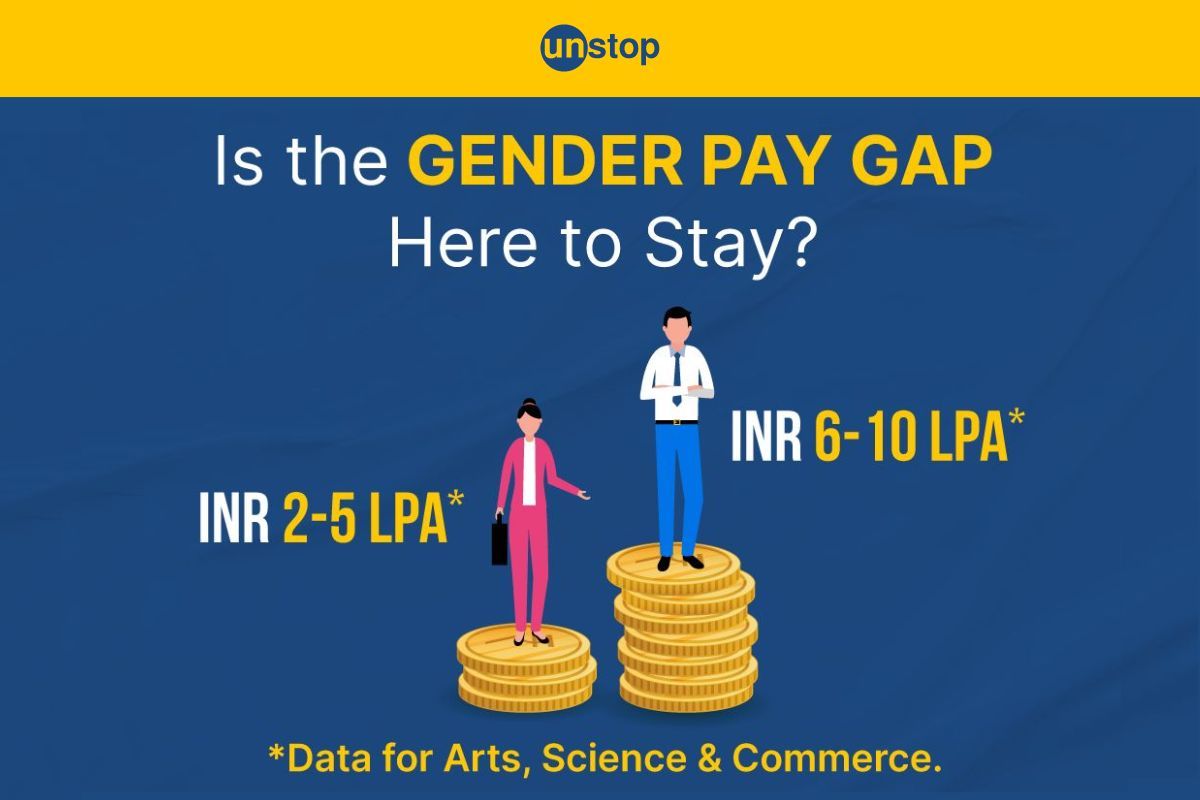
What has remained one of the most persistent things about the workforce? Something that has survived the transition from traditional workplaces to modern offices? It’s the gender pay gap!
The issue of unequal pay based on gender continues to be a prevalent concern affecting many individuals. Despite advancements in workplace equality, disparities in compensation between men and women remain a significant challenge. And the gender pay gap? It begins right after college - even today.
Per the Unstop Talent Report 2024 (UTR’24), female students from the Arts, Science and Commerce streams are being paid less than men - by a wide margin. The most common offer for females in the domain was half of what the men received.
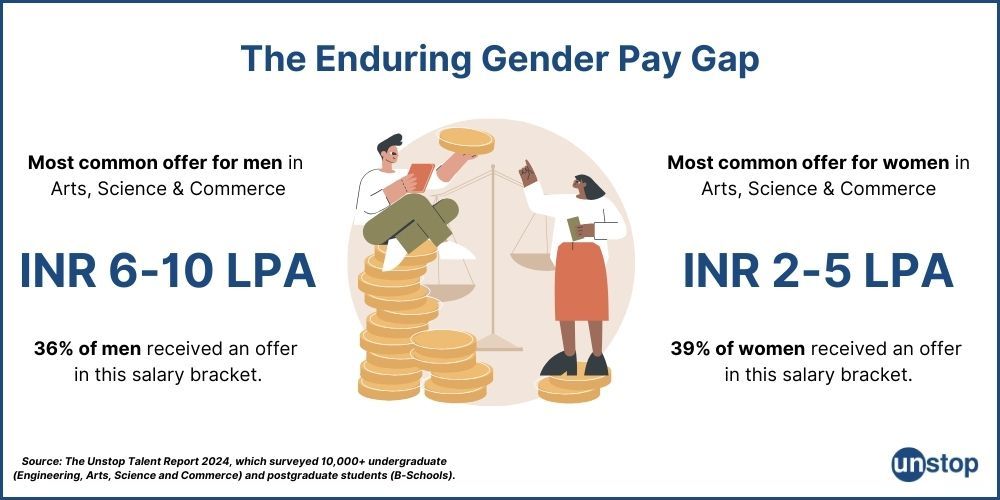
Understanding the root causes and implications of the gender pay gap is crucial for creating a more equitable and inclusive work environment for all.
What is the Gender Pay Gap?
Defining Gender Pay Gap
The gender pay gap is the difference in average earnings between men and women in the workforce. It's usually expressed as a percentage of men's earnings. For example, if the gender pay gap is 15%, it means women earn 15% less than men on average.
The gender pay gap extends beyond individual roles! Gender pay gaps reflect systemic issues that result in women earning less than men on average. These disparities exist even when individuals perform similar work or hold comparable positions within a company.
Equal pay ensures that individuals receive the same pay for the same work, regardless of gender.
Calculation Methods
The gender pay gap is calculated by comparing the average or median earnings of all women working full-time or part-time to the earnings of all men working full-time or part-time within a specific timeframe (e.g., annually, monthly).
Gender Pay Gap (%) = (Average Male Earnings - Average Female Earnings) / Average Male Earnings x 100
This gap can be measured in different ways:
- Unadjusted: This compares the average gross hourly earnings of all working men and women.
- Adjusted: This takes into account factors like education, experience, occupation, and hours worked, aiming to isolate the difference in pay due to gender alone.
Is the Gender Pay Gap Real?
The short answer is yes. The long answer looks at the history of women in the workforce, reflecting on the societal and economic causes behind the gender pay gap. And it’s still a yes.
Women have always been a part of the workforce, predominantly contributing to unpaid labour, in the form of domestic duties. Women entered the paid workforce in the early 20th century - but societal norms led them to earn less for the same work men did. The equal pay movement started gaining traction in the 1940s.
Through the progress and challenges, the movement has continued pushing for workplace equality.
Global Gender Gap Index
While different countries have different measures in place to calculate the gender pay gap and implement gender parity, the Global Gender Gap Index by the World Economic Forum (WEF) is a globally accepted standard.
As per WEF, “(the Index) annually benchmarks the current state and evolution of gender parity across four key dimensions (Economic Participation and Opportunity, Educational Attainment, Health and Survival, and Political Empowerment). It is the longest-standing index tracking the progress of numerous countries’ efforts towards closing these gaps over time since its inception in 2006.”
Its Global Gender Gap Report 2023, based on the data of 146 countries, shows that women continue to earn less than men on average worldwide.
Per the report, the global gender pay gap score in 2023 stands at 68.4%. At this rate, it will take 131 years to reach full parity.
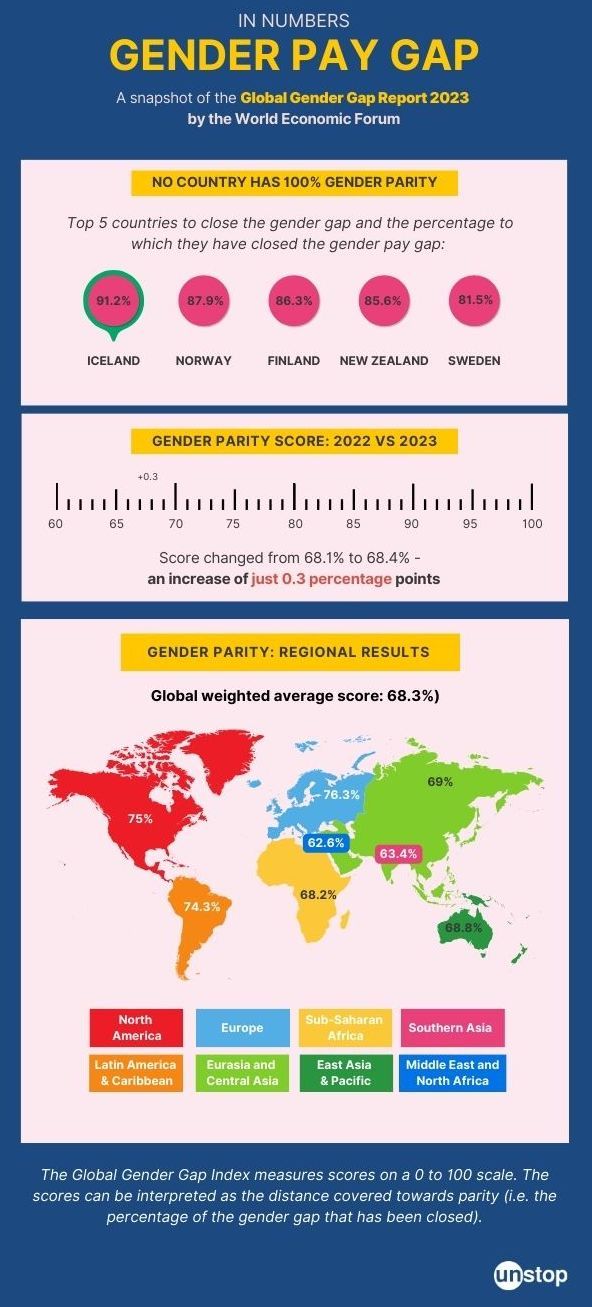
Gender Pay Gap in India
The gender pay gap in India is significant, with women generally earning less than men across various sectors and industries. According to reports, women in India earn, on average, around 28%-35% less than men for performing the same work.
As per the International Labour Organization, the pandemic has “reversed decades of progress in India”.
In 1993-94, on average, Indian women earned 48% less than their male counterparts. The gap declined to 28% in 2018-19. However, preliminary estimates from the Periodic Labour Force Survey (PLFS) 2020-21 show an increase in the gap by 7% between 2018-19 and 2020-21.
India has implemented laws and policies to address gender equality and equal pay, including the Equal Remuneration Act, 1976, which prohibits discrimination in wages based on gender. However, enforcement and compliance with these laws remain challenges.
Factors Affecting the Gender Pay Gap
The gender wage gap is influenced by various factors, including occupational segregation, unequal access to opportunities for career advancement, and societal norms around caregiving responsibilities that often disproportionately affect women's earnings.
Workplace Discrimination
Employed women often face discrimination in the workplace, leading to lower wages compared to their male counterparts. Biases can manifest in various forms, such as hiring practices favoring men over women or promotions being based on gender rather than merit.
Other underlying biases that make it challenging for women to achieve equitable pay in the workplace are:
- Women are more likely to face challenges in negotiating salaries compared to men.
- Stereotypes and biases can lead to undervaluing women's contributions in the workplace.
- Organizations may have policies or practices that unintentionally perpetuate gender-based pay discrepancies.
These discriminatory practices perpetuate gaps in earnings and opportunities, highlighting the need for organizations to address and eliminate such biases.
Job Segregation, i.e. Gender Pay Gap by Profession
One of the major reasons behind gender wage disparities is job segregation, where either men or women dominate certain industries or roles. For example, fields like technology and engineering are predominantly male-dominated, while women often fill caregiving and administrative roles.
This segregation leads to gaps in pay as male-dominated professions tend to offer higher salaries than female-dominated ones. Addressing job segregation by promoting diversity and inclusivity in all sectors is crucial for closing the gender pay gap and ensuring equal opportunities for all employees.
Also Read: How Walmart, struggling to find female coders, partnered with Unstop and exceeded its gender mandate through a diversity hackathon - CodeHers.
Disproportionate Division of Responsibilities
Women are often disproportionately burdened with caring responsibilities, such as childcare and eldercare, which can impact their career advancement and earning potential. Balancing work and caregiving duties can result in women taking leave from their jobs or working part-time, leading to reduced hours and lower wages.
By recognizing and accommodating these needs, organizations can help reduce the impact of caring responsibilities on women's careers and narrow the gender wage gap.
These are the primary causes of the gender pay gap. These, in combination with factors common to all genders, like age, education, and economic forces, impact the pay gap between genders. Let’s study these factors in detail.
How Age Impacts Women’s Earnings
As workers age, their average earnings tend to increase due to accumulated experience and expertise. However, research indicates that older women face challenges in earning equitable wages compared to their male counterparts.
With greater access to education and upskilling opportunities than their predecessors, younger women can step into traditionally male-dominated fields - a chance they are grabbing by the horns. As per UTR’24, in E-schools—a field dominated by men—the average salary offered was nearly the same for men and women.
However, several reports indicate that while the gender gap may be shrinking for entry-level roles, it’s actually widening for women in senior leadership positions. In a 2015 study conducted by the financial services firm Wells Fargo, women over 45 are likely to earn 25% less than their male counterparts.
A more recent study in 2023, conducted by IIM Ahmedabad, shows that not much has changed. At an individual level, women earn 2.2% less than men in similar roles.
However, women in managerial positions earn 3.1% less than men - and a whopping 4.9-6.1% less than men as directors and senior executives.
This gap can be attributed to increased unpaid labour that women are subjected to as they age, especially after marriage or motherhood. These unpaid but time-consuming and energy-intensive activities often force women to reduce the time and energy they can spend in building their career.
It’s a fact! In April 2023, Australia passed a law requiring firms with 100+ employees to release data on the wages of men and women in the firm. Dubbed the Australian Gender Pay Gap Report, the data revealed that a few of Australia’s top corporations had a pay gap bigger than the national average of 19%, reported Reuters.
The ‘Motherhood Penalty’
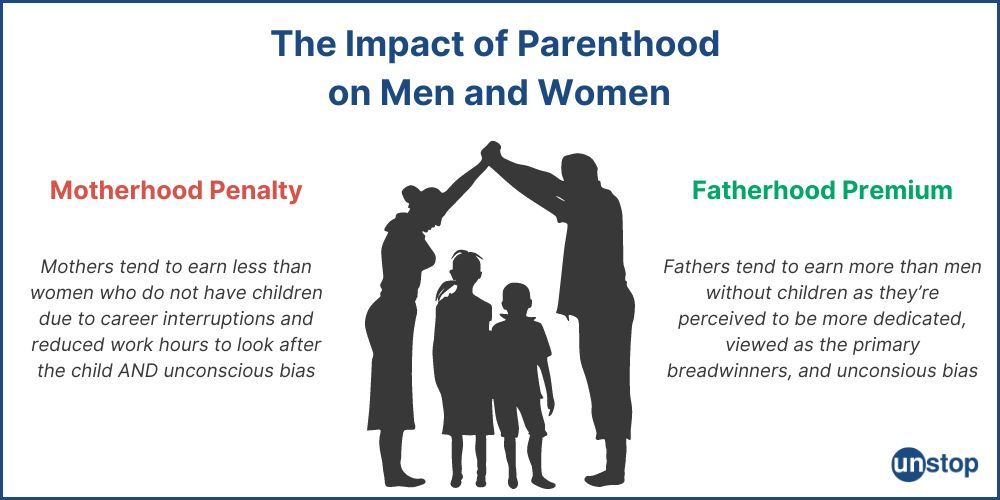
Women also encounter what is termed the "motherhood penalty," where their earnings decrease significantly after having children. This phenomenon stems from various factors, including reduced work hours, taking time off for childcare, and encountering bias in the workplace.
Conversely, fathers may experience a "fatherhood premium," where they receive higher pay following the birth of a child. This disparity highlights the societal norms and expectations surrounding gender roles within families and workplaces.
These pre-set gender roles negatively impact both men and women - men are under greater pressure to financially provide for a family. In contrast, women are forcibly pushed out of the workforce. The other alternative, for women to balance home and career, puts undue pressure on them, leaving them guilt-ridden over their choices.
In an interview with Livemint, Geeta Kapur, Director HR, SJVN (Hydroelectric power generation company), clearly stated that society still expects women to “take a break to look after the children in their growing up years. The concept of collective responsibility is yet to sink in and finds favour with very few.”
Balancing work commitments with childcare duties can overwhelm many working parents, especially new mothers. The lack of affordable and accessible maternity leave policies further complicates this juggling act, leading to career interruptions that impact lifetime earnings.
The struggle to maintain a work-life balance often makes women more likely to opt for part-time roles or positions with flexible hours. These choices, while necessary for caregiving responsibilities, can contribute to the widening gender pay gap over time.
Looking to apply for maternity leave? Explore this guide, which has detailed explanations, rules, and samples on maternity leave application.
Education's Role in Wage Differences
Education levels play a crucial role in wage differences, significantly influencing the earning potential of individuals. Studies consistently show that higher levels of educational attainment correlate with increased wages. For instance, individuals with a college degree typically earn more than those with just a high school diploma.
Yet, wage disparity based on education level is particularly pronounced when comparing genders. Even with similar education and work experience, women often earn less than their male counterparts. The Untop Talent Report 2024 also reported that among B-Schoolers, 55% of men received an offer of over INR 16 LPA. Only 45% of women received an offer above INR 16 LPA.
This wage gap highlights the complex interplay between educational opportunities, gender biases, and workplace structures.
Racial and Ethnic Disparities in Pay
Minority ethnic groups, such as the African-American or Latin-American population in the US, often face discrimination in the workplace, resulting in lower salaries compared to the majority groups. When you add gender to the mix, the pay gap widens.
Racial and ethnic biases prevalent in many workplaces can manifest in hiring practices, promotion opportunities, and salary negotiations, further exacerbating existing disparities.
Women of color often encounter unique challenges due to the intersectionality of race and gender. Thus, despite advancements in gender pay equity, minority women continue to earn significantly lower wages earned by men from a majority group.
For example, studies have shown that Latinas and Black women experience compounded discrimination that results in even lower earnings compared to white women or men of their race.
Closing the Gender Gap
Here are some ways in which organizations can work on reducing the gender pay gap:
Addressing Age and Parenthood-Related Barriers
It is crucial to implement supportive policies and initiatives to tackle the challenges faced by individuals impacted by age and parenthood in the workforce. Companies can introduce flexible work arrangements, extended parental leave options, and mentorship programs, among other measures, to promote gender equality in earnings.
Furthermore, advocating for equal opportunities for both men and women in terms of parental leave and caregiving responsibilities can help mitigate the disparities caused by traditional gender norms.
Systemic Changes for Equitable Workforce
Systemic changes within economic structures are imperative to address the root causes of the gender pay gap. Implementing transparent salary structures, promoting diversity in leadership positions, and offering equal opportunities for career advancement are critical steps towards narrowing the gap in pay and fostering an inclusive workplace culture.
Addressing Racial Disparities
Addressing racial and ethnic disparities is crucial for achieving true gender pay equity for all women. Recognizing and combating these biases requires a multi-faceted approach involving policy changes, diversity initiatives, and organisational cultural shifts.
Promoting Equal Access to Education
To address the wage discrimination stemming from differences in education, it is essential to promote equal access to education and training opportunities for all individuals. By ensuring that both men and women have the chance to pursue higher education and acquire valuable skills, we can work towards narrowing the gender pay gap.
Training Organizations on Unconscious Gender Bias
By raising awareness about the existence of unconscious gender bias, employees can become more mindful of their own biases and how they may impact decisions related to pay and promotions. Through DEI initiatives and trainings like diversity training, individuals can learn to recognize and challenge these biases, leading to fairer evaluation processes and ultimately reducing the gender pay gap.
Additionally, educating employees on the importance of diversity and inclusion can foster a more inclusive work environment where all employees are valued and rewarded based on their skills and contributions rather than their gender.
Iceland’s Long Fight for Equality
Iceland has consistently ranked first on the Global Gender Index - but it’s still not 100% parity. Thus, the women across Iceland, including the Prime Minister, went on a day-long strike in October 2023 - demanding equal pay and an end to gender-based violence. Women refused to work, clean or look after children - taking to the streets to voice their anger at the prevalent workplace discrimination and gender pay gap. It was in 1975 that Icelandic women first staged a walkout - putting a stop to work, literally, to demand equality. In 1976, Iceland passed a law guaranteeing equal rights irrespective of gender. Since then, women have led several partial-day strikes - but not a full-day strike, as this one.
Yesterday 70-100K women and non-binary people went on strike in the annual Women's Strike in Iceland - a beautiful, unifying, rebellious and inclusive day, where we all rose up against sexual violence, unequal pay and injustice ✊
— Ugla Stefanía Kristjönudóttir Jónsdóttir (@UglaStefania) October 25, 2023
📸 Sam Monsen pic.twitter.com/FINfswAG82
While it’s unfair to say that nothing has changed in the past few decades, it’s also crystal clear that much more is needed at an individual, organizational, societal and political level to bridge the gender pay gap. Closing the gender pay gap is essential for achieving economic equality and fostering a fairer society. It’s only the first step in ensuring equity that treats all genders equally, including the members of the marginalized LGBTQIA+ community.
When women are paid less, it not only affects their financial stability but also has wider implications for families and communities. By narrowing the gender pay gap, we promote inclusivity and create opportunities for all individuals to thrive.
Get the latest insights on what makes the future generation of talent work - and what skills are in demand through the Unstop Talent Report 2024.
Frequently Asked Questions
1. What is the gender pay gap?
The gender pay gap refers to the average difference in earnings between men and women in the workforce, often highlighting disparities in pay for equal work.
2. How is equal pay different from the gender pay gap?
Equal pay focuses on ensuring that individuals receive the same pay for performing the same job, regardless of gender. In contrast, the gender pay gap looks at overall earnings differences between men and women across various roles and industries.
3. How is the gender pay discrepancy calculated?
The gender pay discrepancy is typically calculated by comparing the median earnings of men and women in a specific group or industry. This comparison helps identify any disparities in wages based on gender.
4. What are some causes of the gender pay gap?
The gender pay gap can stem from various factors such as occupational segregation, discrimination, lack of representation in leadership roles, and societal norms regarding caregiving responsibilities.
5. What can be done to close the gender pay gap?
Closing the gender pay gap requires a multi-faceted approach that addresses systemic barriers and promotes gender equality in the workplace. Strategies include implementing transparent pay practices, enforcing equal pay laws, promoting salary transparency, providing leadership and career development opportunities for women, addressing unconscious bias in hiring and promotion, and challenging traditional gender norms and stereotypes.
6. Is the gender pay gap illegal?
In many countries, paying women less than men for the same work or work of equal value is illegal under equal pay and anti-discrimination laws. However, the gender pay gap can also be influenced by systemic and structural factors that are more challenging to address through legislation alone.
Suggested Reads:
- HR Metrics: 10+ Important Metrics Explained (With Example & Formula
- Exploring Ethical Leadership With Examples [Assessment Questionnaire Inside!]
- Prioritizing Employee Mental Health - A Guide For HR Professionals
- HR Transformation: Skills, Strategies, And Tools For The Coming Decades!
- Identify And Address Interview Fluff: Pro Tips For Getting Real Answers
I’m a reader first and a writer second, constantly diving into the world of content. If I’m not writing or reading, I like watching movies and dreaming of a life by the beach.
Login to continue reading
And access exclusive content, personalized recommendations, and career-boosting opportunities.
Subscribe
to our newsletter
Blogs you need to hog!
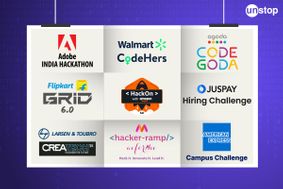
Organize Hackathons: The Ultimate Playbook With Past Case Studies

What is Campus Recruitment? How To Tap The Untapped Talent?
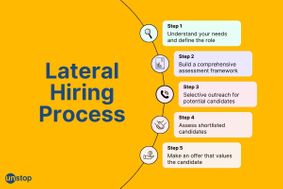
Lateral Hiring: A Complete Guide To The Process, Its Benefits, Challenges & Best Practices
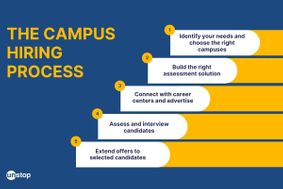












Comments
Add comment